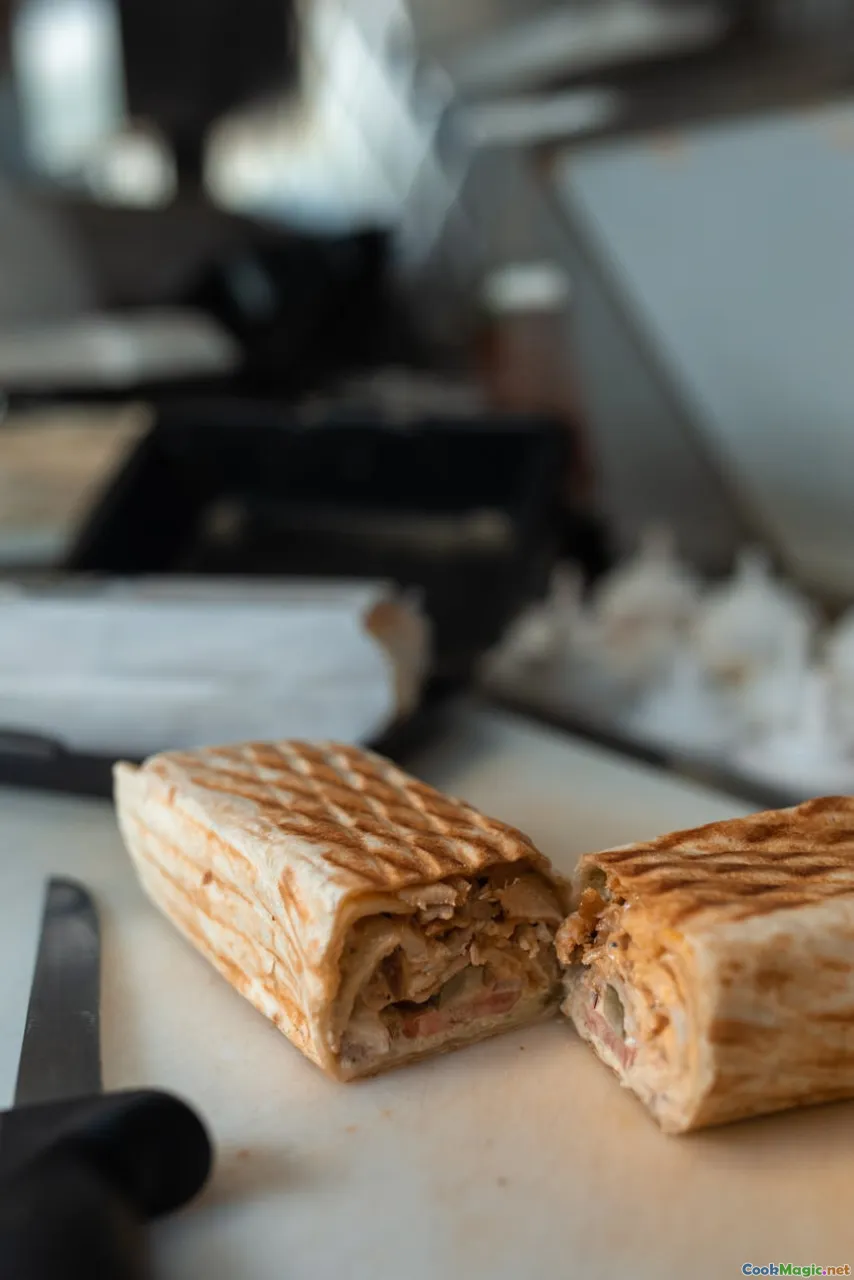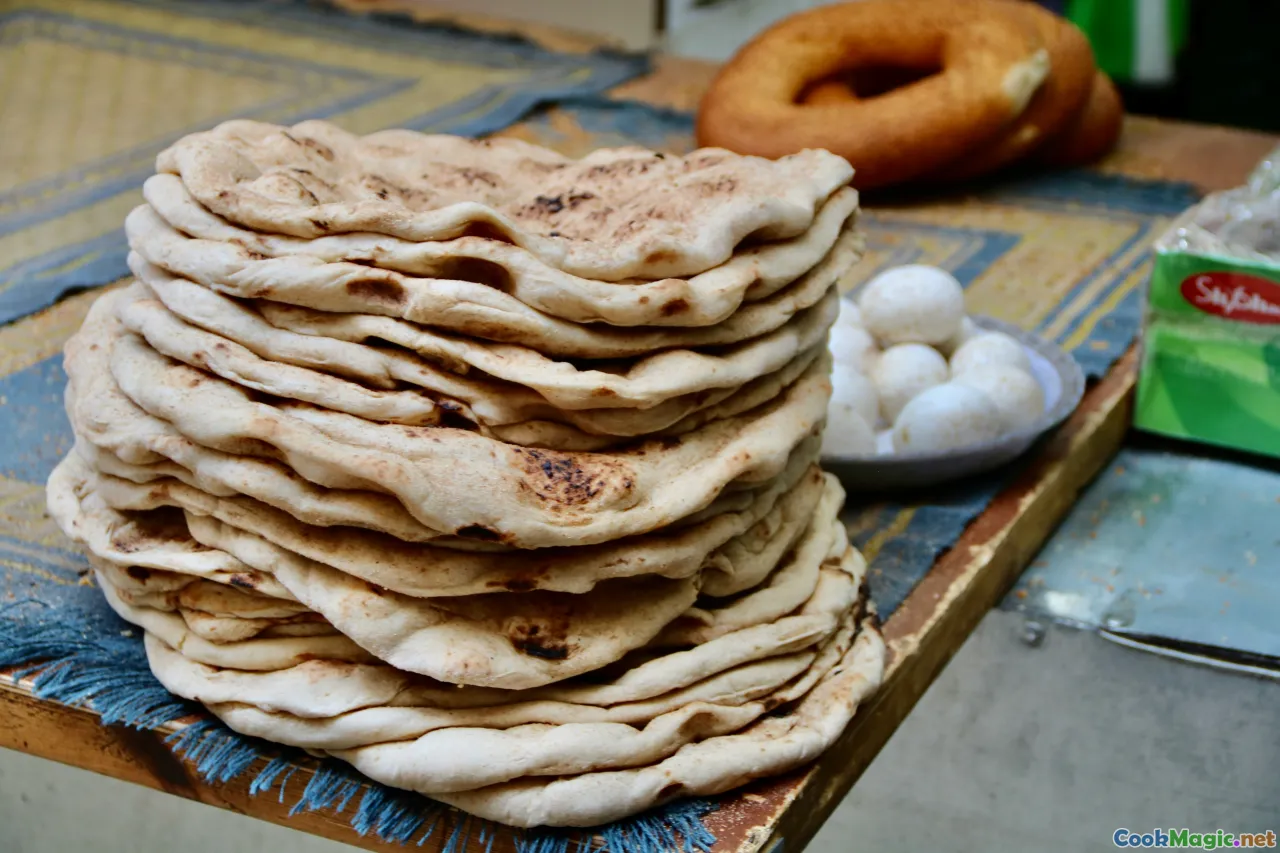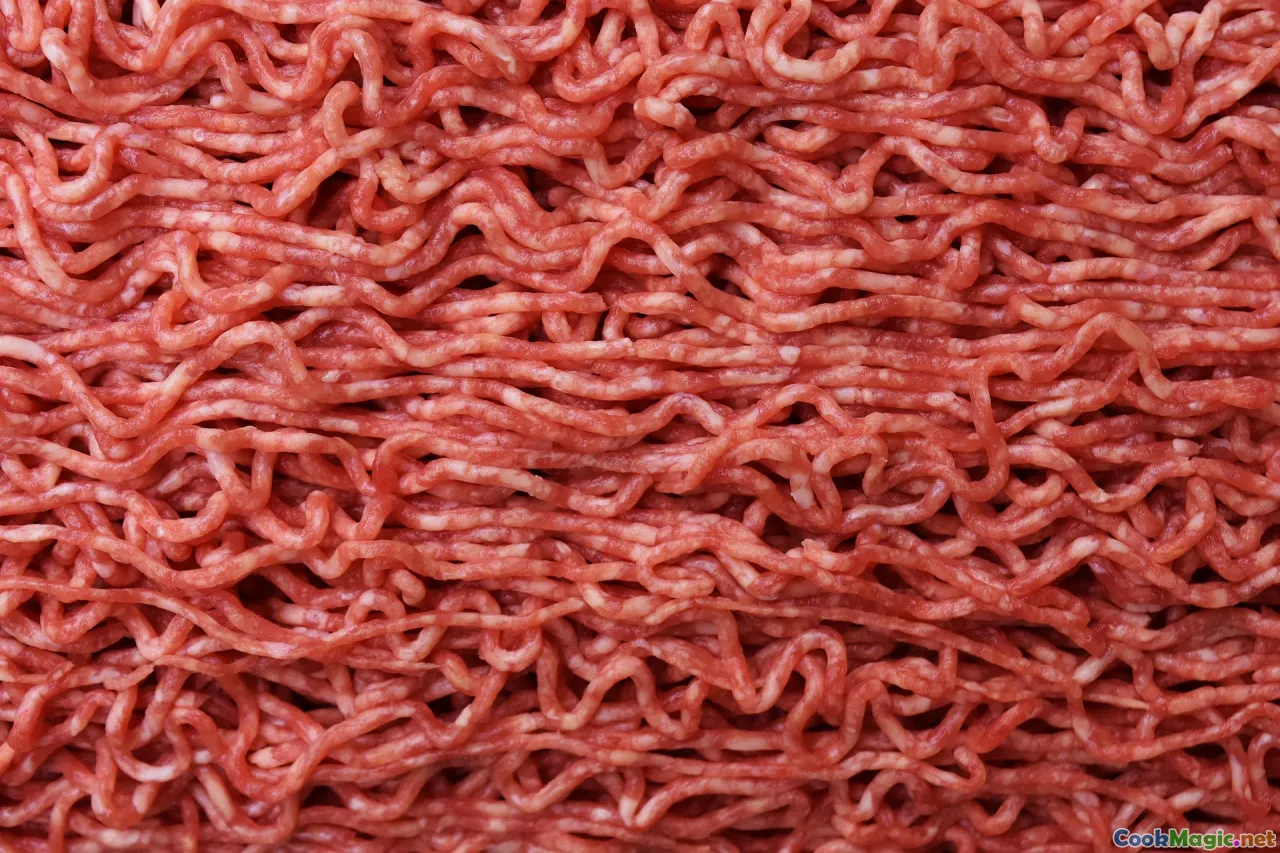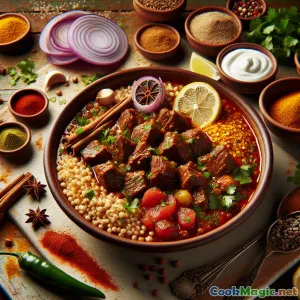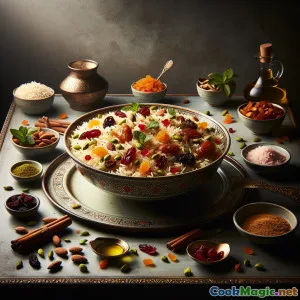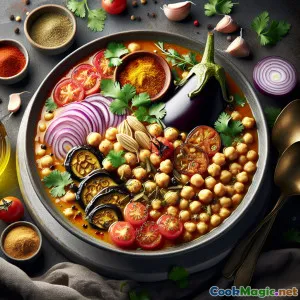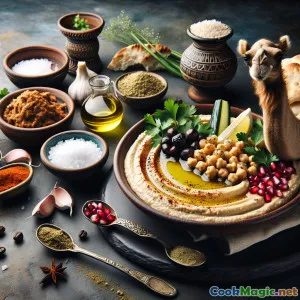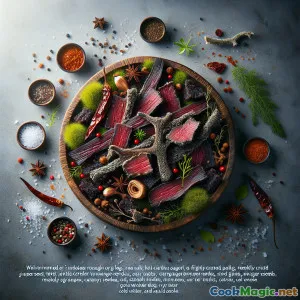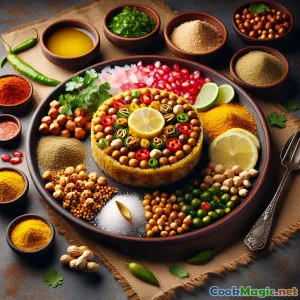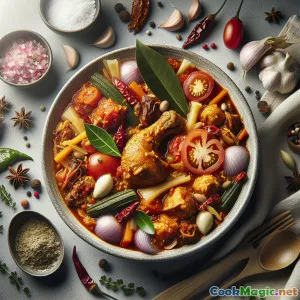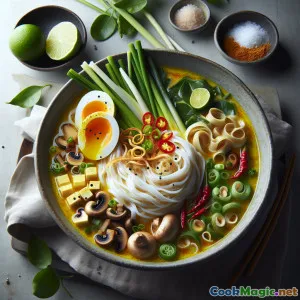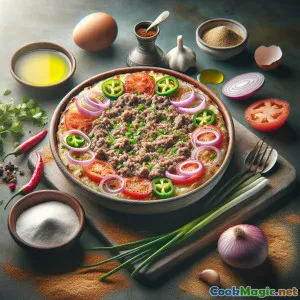
Mutabbaq Doré : Festin de Crêpes Farcies
(Golden Mutabbaq: Stuffed Pancakes Feast)
(0 Avis)0
208
octobre 02, 2025
Signaler un problème
Ingrédients
-
300 grams Farine tout usage
(For the pancake dough)
-
140 ml Eau tiède
(To form a soft, stretchy dough)
-
1 tsp Sel
-
1 tsp Sucre
-
4 tbsp huile de tournesol
(For dough and frying)
-
250 grams Viande hachée
(Alternatively, use lamb mince)
-
1 small Oignon rouge
(Haché finement)
-
2 sticks Ciboulette
(Tranché finement)
-
2 cloves Ail
(Écrasé)
-
1 large Œuf
(Beat for mix)
-
1 medium Piment vert
(Sans graines et finement haché)
-
2 tbsp Coriandre Frais
(Haché)
-
1 small Tomate
(Haché finement)
-
1/2 tsp Poivre noir moulu
-
1/2 tsp Cumin moulu
-
1/4 tsp Poudre de cannelle
(Ajoute une chaleur aromatique)
-
1 tsp Jus de citron
-
1 tbsp Beurre
(For frying, can use ghee or more oil)
(For the pancake dough)
(To form a soft, stretchy dough)
(For dough and frying)
(Alternatively, use lamb mince)
(Haché finement)
(Tranché finement)
(Écrasé)
(Beat for mix)
(Sans graines et finement haché)
(Haché)
(Haché finement)
(Ajoute une chaleur aromatique)
(For frying, can use ghee or more oil)
Nutrition
- Portions: 4
- Taille de portion: 1 large parcel (approx 180g)
- Calories: 395 kcal
- Carbohydrates: 38 g
- Protein: 17 g
- Fat: 18 g
- Fiber: 3 g
- Sugar: 3 g
- Sodium: 610 mg
- Cholesterol: 68 mg
- Calcium: 40 mg
- Iron: 2.3 mg
Instructions
-
1 - Make and Rest Dough:
Mix flour, salt, sugar, and 2 tbsp oil in a bowl. Gradually add warm water until a smooth, sticky dough forms. Knead for 8–10 minutes until elastic. Cover with greased wrap and rest for at least 1 hour to become super stretchy.
-
2 - Prepare Filling:
Heat 2 tbsp oil in a frying pan. Sauté red onion and garlic until fragrant. Add ground beef and brown, breaking up lumps. Stir in tomato, spring onions, chili, cumin, black pepper, cinnamon, and salt. Cook till mixture is dry, then let cool. Stir in egg, lemon juice, and coriander.
-
3 - Divide Dough & Shape:
Divide rested dough into 4 balls. Coat them lightly in oil, cover and rest 10 minutes for easier stretching. On a greased surface, use oily hands to flatten each dough ball into a nearly-transparent square sheet without tearing.
-
4 - Assemble Parcels:
Place 1/4 of the cool filling in the center of each stretched sheet. Fold in edges to make a sealed, square envelope, pressing to close.
-
5 - Fry Pancakes:
Heat a mix of oil and butter or ghee in a flat nonstick pan. Fry each parcel, seam-side down, over medium heat for 2–3 minutes each side until golden brown and crispy. Drain briefly on kitchen paper.
-
6 - Serve Hot:
Cut each Mutabbaq in half. Serve warm with lemon wedges, raita or a side salad. Enjoy immediately for the ultimate crispy, savory treat!
Mix flour, salt, sugar, and 2 tbsp oil in a bowl. Gradually add warm water until a smooth, sticky dough forms. Knead for 8–10 minutes until elastic. Cover with greased wrap and rest for at least 1 hour to become super stretchy.
Heat 2 tbsp oil in a frying pan. Sauté red onion and garlic until fragrant. Add ground beef and brown, breaking up lumps. Stir in tomato, spring onions, chili, cumin, black pepper, cinnamon, and salt. Cook till mixture is dry, then let cool. Stir in egg, lemon juice, and coriander.
Divide rested dough into 4 balls. Coat them lightly in oil, cover and rest 10 minutes for easier stretching. On a greased surface, use oily hands to flatten each dough ball into a nearly-transparent square sheet without tearing.
Place 1/4 of the cool filling in the center of each stretched sheet. Fold in edges to make a sealed, square envelope, pressing to close.
Heat a mix of oil and butter or ghee in a flat nonstick pan. Fry each parcel, seam-side down, over medium heat for 2–3 minutes each side until golden brown and crispy. Drain briefly on kitchen paper.
Cut each Mutabbaq in half. Serve warm with lemon wedges, raita or a side salad. Enjoy immediately for the ultimate crispy, savory treat!
En savoir plus sur: Mutabbaq Doré : Festin de Crêpes Farcies
Mutabbaq: The Middle Eastern Impossible-to-Resist Stuffed Pancake
Mutabbaq is a culinary icon gracing street stalls across the Middle East and Southeast Asia. Translating to "folded" in Arabic, this legendary snack sits at a rich cultural intersection—part pancake, part empanada, all heart. While it’s famously found sizzling on stalls during sunset in passes through Jeddah or wrapped in paper on bustling Jakarta streets as ‘Martabak’, its roots stem from Yemen and Saudi Arabia, yet it’s beloved throughout the region with deliciously diverse local variations.
A Canvas of Cultures and Flavors
What makes Mutabbaq truly noteworthy is its flexibility. The essential structure is beautifully simple—a delicate flour-based dough, painstakingly stretched until gossamer-thin, then generously stuffed, folded, and pan-fried to gloriously crunchy goldenness. While meat—often beef or lamb seasoned abundantly with spices, onion, herbs, sometimes dash of egg—constitutes the core, creative variations abound: think cheesy, vegetarian, or even sweet banana-chocolate renditions.
Originally devised by Yemeni traders and taken across trading routes, Mutabbaq rapidly became street food royalty from Saudi Arabia and Yemen to Bangladesh and Malaysia. Its very adaptability is the secret to this rise—it welcomes whatever’s on hand, blends local flavors with supple ease, and has a shape-shifting identity.
Making Mutabbaq Unique
1. The Stretchy Artful Dough
Unlike thick European pancakes, the dough in this recipe must be kneaded and rested until it’s almost translucent, almost like strudel or phyllo. This ensures crispy edges and a delicate bite. Using oil while shaping and stretching is mandatory! Dough making is therapeutic, please don’t skimp on rest times.
2. Meaty, Herby Goodness
The modest yet flavor-saturated filling is a celebration of local bounty—juicy beef mingles with sweet onions, vibrant green chili, warming spices, and herbs. The surprising addition of a beaten egg, folded in as the filling cools, binds the meat—and infuses subtle creaminess.
3. That Magical Sear
It’s the crispy, amber seal that elevates Mutabbaq. Fry over medium heat: too hot and the crust scorches, too cool and it goes greasy. The smallest brush of butter or ghee lends fragrance and glistening color.
Tips, Notes, and Variations
- For flaky layers, rest dough between oiling and stretching. For thinner results, rest >1 hour at room temp.
- Never overfill: Stay neat to avoid tearing or losing filling—smaller portions yield crunchier parcels.
- Play with fillings: minced chicken and cheese are great! Spinach and feta deliver a bold twist.
- Serve immediately: The sizzle of hot oil preserves ultimate crunch, which mutates to chewiness if left too long.
- Mutabbaq pairs classically with cool yogurt-cucumber raita, sharp pickles, fresh salad, or a dash of chili sauce. A bright lemon wedge is essential!
A Feasting Food for Connection
Sharing a plate of Mutabbaq means more than nourishment; it's a symbol of hospitality, unity, and celebration. This portable-wonder is street-food that welcomes all, transcending borders and sparking conversations.
The singular experience of eating Mutabbaq—hearing the crunchy crackle as you bite in, savoring steamy, well-spiced meat against the airy, laced layers—tells a multicultural story of trade, migration, and culinary joy.
My Thoughts
Making Mutabbaq at home is a rewarding project, perfect for family gatherings or as an offbeat brunch. While the dough stretching takes a little practice, it's part of the fun—a moment for kids and elders to gather, debate fillings, and bond across kitchens.
So next time you’re looking for something that’s part pancake, part gourmet hot pocket, all global history—try Mutabbaq! Whether on the go or leisurely at your kitchen table, you’ll discover why its crossing of continents has made it a beloved classic.

